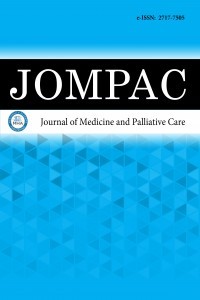Evaluation of the relationship between insulin resistance and different phenotypes of polycystic ovary syndrome
Polycystic Ovary Syndrome, insulin resistance, HOMA-IR, RDW
Evaluation of the relationship between insulin resistance and different phenotypes of polycystic ovary syndrome
Polycystic ovary syndrome, insulin resistance, HOMA-IR, RDW,
___
- Alanya Tosun Ş, Gurbuz T, Cebi A, Tosun A, Gokmen O, Usta M. Association of increased levels of omentin-1 and carotid intima-media thickness with early signs of cardiovascular risk in patients with polycystic ovary syndrome: a prospective case control study. J Obstet Gynaecol Res. 2022;48(1):169-177. doi:10.1111/jog.15077
- Dokuzeylül Güngör N, Güngör K, Yurci A, Cil K, Hatırnaz Ş. Ovarian drilling down-regulates endometrial nuclear factor-κB p65 expression in women with PCOS: a prospective case-control study. Turk J Obstet Gynecol. 2022;19(1):45-50. doi:10.4274/tjod.galenos.2022.44845
- Dokuzeylül Güngör N, Güngör K. Ovarian stimulation drugs alter the metabolite content of the growing follicle: in vivo spectroscopic evaluation of follicle fluid. J Turk Ger Gynecol Assoc. 2021;22(2):132-138. doi:10.4274/jtgga.galenos.2020.2020.0104
- Gungor ND, Gurbuz T, Onal M. Comparison of complication rates after transvaginal ultrasound-guided oocyte pick-up procedures with respect to ovarian response. Clin Exp Reprod Med. 2022;49(2):142-148. doi:10.5653/cerm.2021.04875
- Gürbüz T, Gökmen O, Güngör ND. Polikistik over sendromu bulunan kadınlarda glikoz potasyum oranının tanısal değerinin insülin ile karşılaştırılması. Cukurova Med J 2021; 46: 381-386. doi: 10.17826/cumj.782931
- Gürbüz T, Dokuzeylül Güngör N, Yurci A. Does intracytoplasmic sperm injection increase the risk of gestational diabetes in patients with polycystic over? Anatolian Curr Med J. 2021;3:53-58. doi:10.38053/acmj.837292
- Gurbuz T, Alanya Tosun S, Cebi A, Gokmen O, Usta M. Investigating fetuin-a and paraoxonase-1 activity as markers in polycystic ovary syndrome based on body mass index: a prospective case-control study. Cureus. 2021;13(10):e18553. doi:10.7759/cureus.18553
- Hatirnaz E, Hatirnaz S, Kanat-Pektas M. The impact of timing for estrogen supplementation in polycystic ovary syndrome patients undergoing primed in vitro maturation. J Obstet Gynaecol Res. 2021;47:2684-91. doi: 10.1111/jog.14858
- Yurci A, Dokuzeylül Güngör N, Güngör K, Hatırnaz Ş. Correlation of serum leptin and ghrelin levels with endocrine and reproductive parameters in women with clomiphene citrate resistant polycystic ovary syndrome. Turk J Obstet Gynecol. 2022;19(2):124-129. doi:10.4274/tjod.galenos.2022.84883
- Subramaniam K, Tripathi A, Dabadghao P. Familial clustering of metabolic phenotype in brothers of women with polycystic ovary syndrome. Gynecol Endocrinol. 2019;35(7):601-603. doi:10.1080/09513590.2019.1566451
- Wang X, Xu T, Liu R, et al. High-fiber diet or combined with acarbose alleviates heterogeneous phenotypes of polycystic ovary syndrome by regulating gut microbiota. Front Endocrinol (Lausanne). 2022;12:806331. doi:10.3389/fendo.2021.806331
- Shirazi FKH, Khodamoradi Z, Jeddi M. Insulin resistance and high molecular weight adiponectin in obese and non-obese patients with polycystic ovarian syndrome (PCOS). BMC Endocr Disord. 2021;21(1):45. doi:10.1186/s12902-021-00710-z
- Yang YL, Zhou WW, Wu S, et al. Intestinal flora is a key factor in insulin resistance and contributes to the development of polycystic ovary syndrome. Endocrinology. 2021;162(10):bqab118. doi:10.1210/endocr/bqab118
- Eftekhar M, Mirhashemi ES, Molaei B, Pourmasumi S. Is there any association between vitamin D levels and polycystic ovary syndrome (PCOS) phenotypes?. Arch Endocrinol Metab. 2020;64(1):11-16. doi:10.20945/2359-3997000000177
- Cutler DA, Pride SM, Cheung AP. Low intakes of dietary fiber and magnesium are associated with insulin resistance and hyperandrogenism in polycystic ovary syndrome: a cohort study. Food Sci Nutr. 2019;7(4):1426-1437. doi:10.1002/fsn3.977
- De Diego MV, Gómez-Pardo O, Groar JK, et al. Metabolic impact of current therapeutic strategies in polycystic ovary syndrome: a preliminary study. Arch Gynecol Obstet. 2020;302(5):1169-1179. doi:10.1007/s00404-020-05696-y
- Krentowska A, Kowalska I. Metabolic syndrome and its components in different phenotypes of polycystic ovary syndrome. Diabetes Metab Res Rev. 2022;38(1):e3464. doi:10.1002/dmrr.3464
- Krentowska A, Łebkowska A, Jacewicz-Święcka M, et al. Metabolic syndrome and the risk of cardiovascular complications in young patients with different phenotypes of polycystic ovary syndrome. Endocrine. 2021;72(2):400-410. doi:10.1007/s12020-020-02596-8
- Wang R, Gu Z, Wang Y, et al. A “one stop shop” decision tree for diagnosing and phenotyping polycystic ovarian syndrome on serum metabolic fingerprints. Adv Funct Mater 2022;32:220-230. doi: 10.1002/adfm.202206670
- Kim JJ, Choi YM. Phenotype and genotype of polycystic ovary syndrome in Asia: ethnic differences. J Obstet Gynaecol Res. 2019;45(12):2330-2337. doi:10.1111/jog.14132
- Mumusoglu S, Yildiz B. Polycystic ovary syndrome phenotypes and prevalence: differential impact of diagnostic criteria and clinical versus unselected population. Curr Opin Endocr Metab Rese. 2020;12:66-71. doi:10.1016/j.coemr.2020.03.004
- Bjekić-Macut J, Vukašin T, Velija-Ašimi Z, et al. Polycystic ovary syndrome: a contemporary clinical approach. Curr Pharm Des. 2021;27(36):3812-3820. doi:10.2174/1381612827666210119104721
- Tavares A, Rêgo Barros RC. The prevalence of metabolic syndrome in the different phenotypes of polycystic ovarian syndrome. a prevalência da síndrome metabólica nos diferentes fenótipos da síndrome do ovário policístico. Rev Bras Ginecol Obstet. 2019;41(1):37-43. doi:10.1055/s-0038-1676568
- Başlangıç: 2020
- Yayıncı: MediHealth Academy Yayıncılık
Os sacrum morfometrik analizi ve klinik anatomisi
Ayşe Gül KABAKCI, Gamze TAŞKIN ŞENOL
Ekstafamilyal ve intrafamilyal ensest İstismarın retrospektif karşılaştırılması
Miyometriyum kalınlığı ölçümü doğum sonrası kanama miktarını ve doğum şeklini öngörebilir mi?
Ahmet DEMİRCİ, Tayfur ÇİFT, Süleyman Serkan KARAŞİN
Monosit-HDL-kolesterol akut pankreatitte hastalık şiddetinin belirleyicisi midir?
Ruhsen ÖZÇAĞLAYAN, Attila ONMEZ
Kronik böbrek hastalığı progresyonunu etkileyen faktörler
Tıp öğrencilerinin bağırsak alışkanlıkları ile kronik kabızlık arasındaki ilişki
Selman ALKAN, Murat ÇAKIR, Alper VARMAN
Mehmet AĞAR, Murat ÖNAL, Halime ÇALI ÖZTÜRK
Geriatrik COVID-19 hastalarında prognostik beslenme indeksi ile mortalite arasındaki ilişki
Cansu DURAK, Ebru ŞAHİN, Yasar Yusuf CAN, Kübra BOYDAĞ GÜVENÇ, Alican SARISALTIK, Fatih VAROL, Halit CAM
